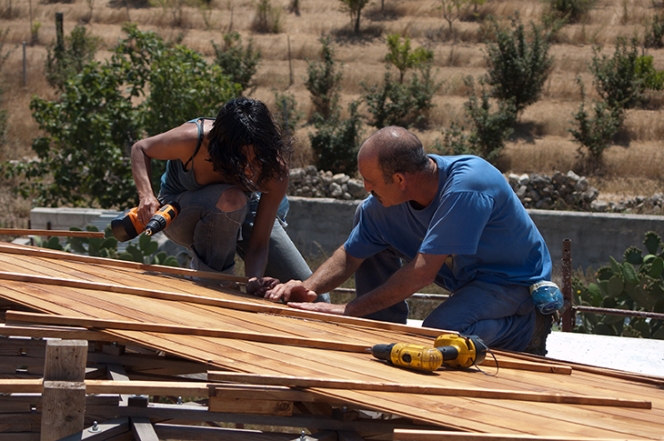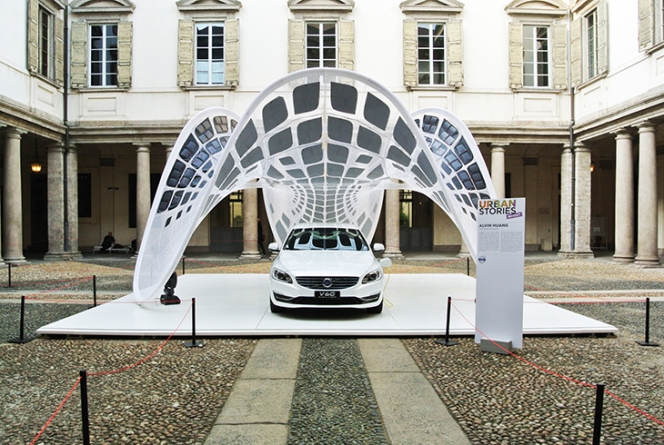Your Cart is Empty
Recent Articles
- Efficiency Meets Innovation: SketchUp 2024 Unveiled
- Maxon One Spring 2024 Release Packs Particle Power, Toon Shading, and More
- TurboCAD 2024 Unveiled by IMSI Design: Discover the New Features and Enhancements
- Exploring the Latest InfraWorks 2025 Updates
- Introducing the Latest Innovations in Autodesk's ReCap Pro 2025
- Discover the Latest Enhancements in Civil 3D 2025
- Exploring the Newest Features and Enhancements in Revit 2025
- Explore the Latest Features in Vantage 2.3 Update
- Explore the Latest AutoCAD 2025 Enhancements: Activity Insight, Smart Blocks, and Apple Silicon Support
- Unveiling Enscape 4.0: Revolutionizing Design with Unified Experience for macOS and Windows Users
The Edge: Professor Sofia Colabella, On the Gridshell.
July 28, 2015 9 min read
Novedge: Tell us a little bit about yourself and what you do.  Sofia Colabella: I am an Architect and PhD in “Technology of Architecture”, graduated at the University of Naples “Federico II”, where I presently teach “Construction Systems” as Sessional Lecturer. As an Architect, I am the co-founder of Cmmkm Architecture and Design, a practice based on the concepts of sustainable Architecture, contemporary living, low-cost buildings, self-construction, transformable, deployable and self-assembled structures, fast construction systems. As a researcher, my interests are in the fields of Interior Design and timber Architecture, but my specific focus is on the design and construction of timber post-formed gridshells. That’s a passion and a challenge at the same time, which led me to co-found, together with Sergio Pone, Bianca Parenti and Daniele Lancia, the Italian company Gridshell.it. So far, we have built 13 gridshells, which we managed entirely from conceptual design to construction. We integrate numerical simulation with physical models or prototypes, and our company develops as a technology-based extension of the DIY tradition – we are “makers”.
Sofia Colabella: I am an Architect and PhD in “Technology of Architecture”, graduated at the University of Naples “Federico II”, where I presently teach “Construction Systems” as Sessional Lecturer. As an Architect, I am the co-founder of Cmmkm Architecture and Design, a practice based on the concepts of sustainable Architecture, contemporary living, low-cost buildings, self-construction, transformable, deployable and self-assembled structures, fast construction systems. As a researcher, my interests are in the fields of Interior Design and timber Architecture, but my specific focus is on the design and construction of timber post-formed gridshells. That’s a passion and a challenge at the same time, which led me to co-found, together with Sergio Pone, Bianca Parenti and Daniele Lancia, the Italian company Gridshell.it. So far, we have built 13 gridshells, which we managed entirely from conceptual design to construction. We integrate numerical simulation with physical models or prototypes, and our company develops as a technology-based extension of the DIY tradition – we are “makers”.  Photo credits Daniele Lancia.
Photo credits Daniele Lancia.
Novedge: Can you talk about some of your projects that excite you the most?
Sofia Colabella: Overall, our work and research on timber structures is what excites me the most. For instance, in the fall of 2014, I had the opportunity to visit the university of Melbourne and co-coordinate “Issues in Technology”, an intensive subject focused on low-tech building techniques and self-construction. I worked together with Alberto Pugnale (a local lecturer, at the Melbourne School of Design) and Sergio Pone (Professor at UniNa), to erect the first Accoya post-formed gridshell of Australia! We had a very engaged group of master’s students at the Melbourne School of Design.https://player.vimeo.com/video/153214482?color=ffffff&title=0&byline=0&portrait=0
Accoya Timber gridshell from Alberto Pugnale on Vimeo.
As Grhell.it, we provided design, structural and construction support. Further, Accsys Technology, which produces the patented “Accoya” timber, a sustainable treated wood with high durability, donated part of the material used. The design was reduced to essential: a cross-shaped symmetric flat grid made of four layers was meant to be formed into a doubly-curved gridshell. Construction was also thought to be simple and low-tech: erection was meant to take place forcing the four sides towards the centre, which, almost automatically, would have risen along the Z axis. We bent the lattice with four tackles with about 100m of non-extensible rope. A tackle is a simple machine to lift heavy loads, which was already known during the golden years of the Roman Empire. Our aim was to take advantage of ancient and low-tech building techniques and self-construction methods to erect contemporary lightweight structures designed through the use of advanced digital tools. Using massive wood was also a specimen.
Another pivotal experimentation on the erection system was tested during the construction of “Toledo 2”, a gridshell pavilion in the courtyard of the School of Architecture of Naples, again in 2014. The project team featured Gridshell.it, with Bernardino D’Amico, Oreste Mammana and Raffaele Stabile. Here we also tested a new monitoring system, with the aim to facilitate the overall construction and its precision. In fact, to get the same shape you design is not easy, and we are working hard on making that process simple and cost-effective.
Finally, I have to confess my preferred gridshell is Trio, a project where Architecture and structure meet happily. Let me now switch typology , but not topic. My next appointment is Villa Pennisi in Musica (VPM), a summer school and festival in which I am going to participate soon, together with the Gridshell.it team, for the fourth year in a row. VPM is dedicated to exhibit the excellence in the fields of classical music, Architecture and Performance Design, and encourages active participation of different arts and disciplines to create a unique listening experience for both audience and musicians. Here you can find a wide explanation, and also a brief speech of mine.https://player.vimeo.com/video/93459032
Villa Pennisi in Musica 2013 – a film by Anton Giulio Onofri from Villa Pennisi in Musica on Vimeo.
Together with the workshop students (Arch Lab) we built ReS, an acoustic shell for open-air Chamber Music concert. ReS was developed from a Fan-Shaped plan mixed with the silhouette of old fashioned gramophones, which were able to amplify and project the sound according to a certain directivity. Each and every part of the shell was made of timber and reversible joints with no glue, hence allowing a simple manufacturing, a sustainable process and a cost effective structure. A sophisticated numerical form-finding process was used to reach such a shape and technological simplification. ReS can be fine-tuned for different stage settings, before the beginning of each performance, in order to guarantee a high level of flexibility to the overall system. ReS has won the Peter Lord Award 2015, conferred by IOA (Institute of Acoustic of UK), as a “project that showcases outstanding and innovative acoustic design”. This project has been developed by Serafino Di Rosario (Buro Happold Engineers) Sergio Pone , Bianca Parenti, Davide Ercolano , Daniele Lancia, Eduardo Pignatelli and myself. This year, we are going to build a new ReS, designed through optimisation rather than form-finding, and developed for the master’s degree thesis by Eduardo Pignatelli, Gabriele Mirra and Gabriella Lucci. The shell has already been tested in Naples this June, as a prototype used during the open-air concert performed by the “Orchestra Scarlatti Young” and David Romano, concert master and Artistic Director of “Villa Pennisi in Musica”. This experience will also see the partnership with LEGO, through the launch of a new building contest aiming at helping Architecture students to explore new ways of designing sustainable structures. The challenge is to amplify the sound of the destroyed old Theatre Bellini of Acireale, using the over 1,200 white and transparent bricks of the LEGO Architecture Studio set. More details of this contest here.
Novedge: Can you tell us a little more about the nature of a "gridshell"?
Sofia Colabella: You may find many definitions of “gridshell”, a word that became part of our architectural vocabulary only in 1974, when the Institute for Lightweight Structures, based in Stuttgart, dedicated a complete research book to that structural typology. A gridshell can be defined in two ways: as a shell structure discretised into linear elements, which constitutes a lattice; and as a three-dimensional structure which resists applied loading through its inherent shape. Gridshells represent an efficient structural form, that is why we could say they are sustainable by design. Timber gridshells can be made by laying out a lattice slowly pushed into a given shape. The first double layer gridshell was pioneered by Frei Otto and the group of structural consultant, Structure 3, for the Bundesgartenschau in Mannheim, Germany, in 1975 (more info: Happold E., Liddell W. I. Timber lattice roof for the Mannheim Bundesgarten, The Structural Engineer, Vol. 53, No. 3, March 19, 1975). In the last ten years, wooden post-formed gridshells have offered an exceptional solution to cover large space with a free-form-like shape. 
Novedge: Innovation is a big part of your practice, what are the different areas of your research?
Sofia Colabella: My PhD Thesis is titled “The innovative uses for small wooden laths”, and concealed a small maybe unattainable hope: in Italy, in the last 50 years, the heavily decrease of small dimension wooden products also derived from coppice, caused the recession of forest industry with huge loss for the woodland heritage and for the society which lied hits economy on wood cutting and manufacturing. For this reason, my aim was to contribute to the growth of locally sourced materials and the use of local trades, to trigger a new market for wood products. That was the beginning of my experience with timber gridshells: first, studying through the work of Frei Otto and Vladimir Grigor'evič Šuchovand, then, experimenting with the aid of a series of research programs. A small amount of small wooden laths can be placed just where needed by defining the optimal structural form through form-finding. Therefore, form-resistance becomes the way to reduce environmental impacts within a wider idea of social and environmental sustainability. As I said, Form-finding is the process to achieve all this. New tools for parametric design can be the key to obtain what our masters (Frei Otto above all) have researched for life. That can be achieved in acoustic shells, where the form is built accordingly with his acoustic behavior, or in a gridshell, where the distribution of small laths can be considered the only way to reach a large span. Generally speaking, the different areas of my research deal somehow with the reduction of energy consumption.
Novedge: How do you make a structure lighter?
Sofia Colabella: Lightness is a complicated job, dealing with many different, interrelated subjects, such as shape, structure, material, process and the balance between them; it can be read in different ways, depending on one’s interests. Nature provides a lot of examples, as well as nomadic cultures. Making things lighter is not just a matter of choosing a structural typology, nor a “light” material, but the combination of them, given a goal; it deals with the research of the right structural form, without using the muscle of powerful materials. Digital simulation, as well as structural optimization, have led to a strategic approach, offering new possibilities that were still inconceivable just a few years ago. The key is, today as in the past, the minimum use of energy and the least amount of resources. A few weeks ago I had the opportunity to participate as instructor at a workshop title exactly “How To Make Things Lighter” at the Nanjing University. I was invited by Dr. Alberto Pugnale, and the workshop was coordinated by Prof Tong Ziyu, and supported by the Dean Prof Ding Wowo. In that occasion, Karamba was used to develop the form and to optimize the geometry of gridshells as paradigm of efficient structural form and the physical models as a mean to explore the digital results. I think this was a great opportunity to explain the reasons to subtract weight, as Italo Calvino explained “Thus, astride our bucket, we come out into the new millennium, without hoping to find anything more than what we are able to bring. The lightness, for example” in the first of his Lezioni Americane, Six memos for the Next Millennium. Photo credits Sergio Ceglio.
Photo credits Sergio Ceglio.
Novedge: What software do you use?
Sofia Colabella: We first achieved high-level skills in gridshell construction. Then, we developed a form-finding and optimisation tool within Grasshopper, a Rhinoceros plugin. Rhino is a very powerful NURBS-based CAD for Architects and Industrial Designers, and Grasshopper is a ‘visual’ scripting environment . The parametric geometry of the starting flat grid, intermediate connections, timber species, laths directions, type of bracing system, are fed into our code as inputs. The calculations start from the definition of the flat grid, its point of connection to the ground and the boundary (attractors) chosen by design. This step of interactive simulation, optimisation and form-finding is achieved through Kangaroo a live physics engine which works directly within Grasshopper. Here you can see a video where the digital simulation matches the real construction: I presented this collective work at the Iass (International Association for Shell and Spatial Structures) 2013, you can find here the paper we wrote for this occasion. We also use Karamba , another Grasshopper plug-in, to perform real-time Finite Element analyses of our parametric geometric model. That is a first qualitative structural analysis, then followed by a more accurate simulation, by means of Abaqus, of the deformation of the flat lattice. More accurate info here.
Novedge: What are the latest advancements in Architecture that excite you the most?
Sofia Colabella: Parametric Design, efficiency, adaptation, innovation, responsiveness, ecological approach and beauty are some of the keywords I am interested in. I also share the concern of many researchers about the actual meaning of a digital revolution in Architecture, which should also define ‘new tools of thought’, rather than simple form-giving. I am attracted to ecological values, to the limits and elegance of lightweight structures, to the search for lightness you definitely do not find in the world of heavy-duty man-made materials; and yet, to the algorithmic procedures (recently migrated into the Architectural practice) as a key to optimize their behaviour.
Novedge: What is the hottest place on earth for Architecture right now?
Sofia Colabella: "Hot" things happen everywhere, but mainly where there is a lack of resources to support them. I am thinking about the tent domes, the Yurt, and so forth, deployable wooden frame carrying a felt cover, perfect examples of doing highly with very little. On the other hand I recall Japanese contemporary architecture, where the smartest architects and engineers make high-end use of optimisation techniques to improve the structural behaviour of the “Architecture in electronic age” as called by Toyo Ito; here, Architecture must function as the extended form of skin in relation to both nature and information at once and engineering can make them efficient. Different power up for a very hot temperature in both cases.
Novedge: What is a quality an Architect should have?
Sofia Colabella: Many conflicting things come into my mind on this question (optimism, realism, persistence, creativity, insanity, and so forth). But two of them seem crucial to me: the aim to understand the behavior of things with your own hands, and the belief in collaboration: growing up as an individual, sharing knowledge and skills as a cluster. I could not have done that kind of things without my colleagues, partners, fellows and friends.
To keep up with Sofia's research follow her on ResearchGate and check out Gridshell.it.
To keep up with Novedge's latest software Specialsand New Releases visit the Novedge website . And don't forget to follow us on Facebook and Twitter for software news and great interviews!
Related articles
Also in NOVEDGE Blog

Maxon One Spring 2024 Release Packs Particle Power, Toon Shading, and More
April 10, 2024 4 min read
Read More
TurboCAD 2024 Unveiled by IMSI Design: Discover the New Features and Enhancements
April 10, 2024 2 min read
Read MoreSubscribe
Sign up to get the latest on sales, new releases and more …






